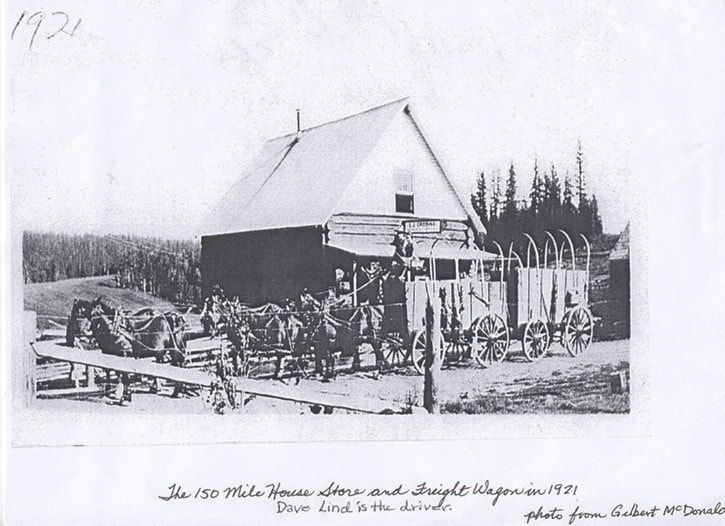Recently, the 153 Mile Store was in the news.
I have been in that store on several occasions and I truly believe that it is an historical gem which must be preserved.
The old buildings around the store once served as a roadhouse and its associated outbuildings, and they have an interesting history.
Louis Crosina was raised in the Italian Tyrol, near the Austrian border. As he grew up, he heard tales of the Canadian gold rush, sent by letter from an uncle who had emigrated to B.C.
In 1882, at the age of 15, Louis, along with three older companions, set sail for America, where he planned to meet up with that uncle.
Unfortunately, the letters had the return address of British Colombia, and that spelling, along with the fact that none of the four adventurers had any idea of geography, nor did they speak any English, resulted in the booking passage to Colombia, South America.
During the voyage, the mistake was discovered, but the best the ship’s captain could do was to let the four travellers off at Colon, Panama, approximately 5,000 miles from their intended destination. They did not have enough money to continue the journey, so the four of them signed on to work as labourers on the Panama Canal project, which was going full speed at the time.
The conditions were deplorable — a hot, humid climate, back breaking physical work, unsanitary living conditions and rampant disease.
Within a month, all three of Louis’s companions were dead, either from malaria or yellow fever.
Louis also came down with disease, but he managed to survive long enough to earn the money needed for a working passage on a ship bound for San Francisco.
There, he found work in the livery business, mending tack, taking care of horses and doing wagon repairs.
The job was not too difficult physically, and Louis excelled at it. He put money aside, and within a year, he was able to purchase passage on a Steamer bound for B.C.
Gradually, he regained his health, and within a year of his arrival he was able to take on more physical jobs.
Louis made his way to Yale, B.C. His knowledge of horses, wagons and tack brought him jobs in the freight business, including driving freight wagons on the lower Cariboo Wagon Road (south of Ashcroft and in the Fraser Canyon).
By 1887, Louis had come to the Cariboo region.
He pre-empted land behind the 122 Mile Ranch (near Clancy’s at Lac La Hache) and he worked on and off for the BC Express Co. at Tingley’s 134 Mile Ranch.
In 1895, a young school teacher, Clara Noble came to teach at Lac La Hache. Louis fell in love and courted her, and they were married in 1897.
Clara had no interest in running a roadhouse, or in operating a store. The couple moved to the Mountain House in 1899, but when that place was sold, they left to establish a ranch of their own halfway between 150 Mile and Mountain House.
So the 153 Mile Ranch began.
Louis built a small log home, followed shortly by a blacksmith shop and a small barn.
The Crosinas had no intention of operating a store at that time, but they were more or less forced into it when the day labourers never wanted money — “just a little grub or some other things.”
So Clara bought a set of scales and started to keep a stock of a number of standard items.
By 1906, Louis had finished a large, two-storey log home, and before long, travellers and freight wagon drivers were asking for rooms and meals.
Thus, the lady who swore she would never run a roadhouse began her career as an innkeeper.
She prided herself that her stopping house never had any bedbugs.
Every Saturday, she had a tub of disinfectant carried to each room, and every bed was scrubbed down and every mattress was wiped clean.
Quite a settlement was built around the roadhouse, and the store was a major part.
It became so popular that it soon outgrew the small log building where it began, and in 1914 a “new” log store was opened.
That is the building that still stands today. It continued to prosper and grow, and in its time it supplied the Bullion Pit, and mines in Horsefly and Likely, along with many inhabitants of the 150 Mile area.
The 153 Mile House operated continuously for 35 years.
The popularity of the roadhouse, with its clean rooms and good food; the store, where you could buy just about anything, and Louis’s blacksmithing and repair services made it a going concern, especially for teamsters.
It never was a regular stagecoach stop. When traffic was heavy, it was not unusual for Clara to work all day preparing meals and running the store for the teamsters while Louis would shoe horses and repair wagons and tack at night while the men slept.
The Crosinas carried on until Clara’s death in 1936.
After that, Louis moved to Abbotsford to live with a daughter, and the store and ranch was bought by their eldest daughter, Lilly.
She continued the operation until 1939, when the rationing and labour shortage caused by the Second World War forced her to close the roadhouse.
The store, however, remained open, and even after she sold the ranch to Joe and Peggy Patenaude in 1958, she continued to live at the ranch and to operate the store.
In 1963, Lil died of a sudden heart attack behind the counter, and the store never again reopened for business.
It still contains hundreds, perhaps thousands, of items and is a true time capsule of a real country general store.
